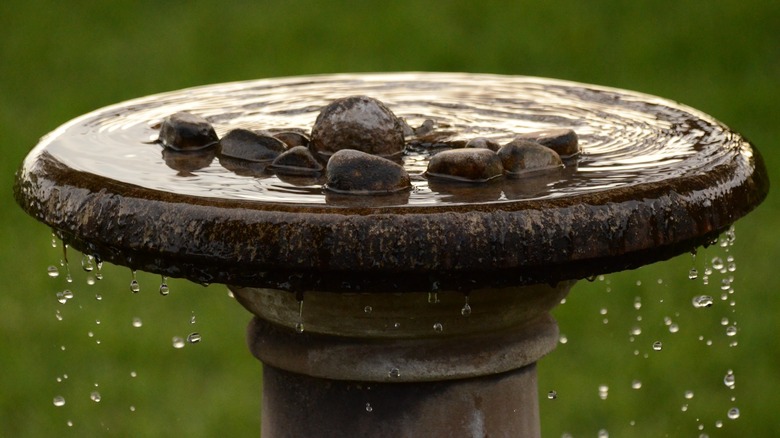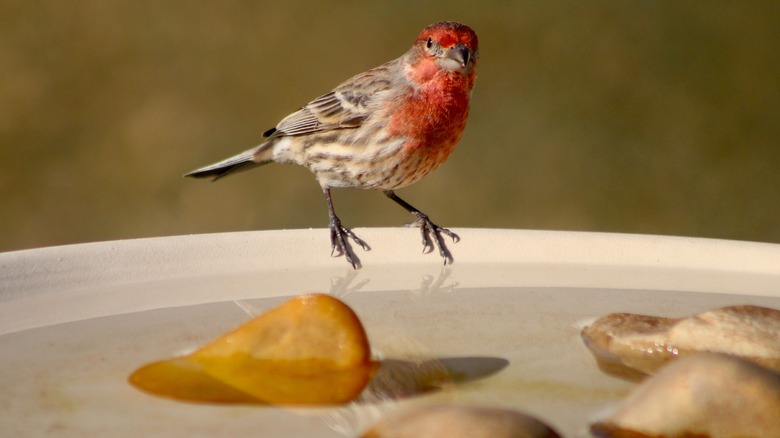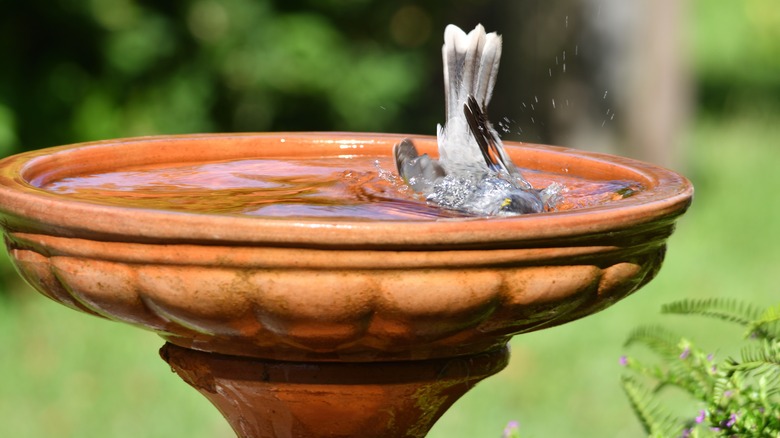Why You Should Consider Adding Rocks To Your Birdbath
An easy addition to a backyard's aesthetic, birdbaths are a simple water feature that many homes have in their yard. Yet, these pieces are more than just ornamental — they're functional and important for wild birds. More than that, they're made better with the inclusion of rocks to aid our feathered friends.
According to ornithologist Joe Smith's piece for The Nature Conservancy, birds take baths for myriad reasons. He noted, however, that science has been a bit inconclusive about bathing habits. Though a nice soak may help a bird's feathers stay in good shape for longer, they could also help birds stay alive. A study in Animal Behavior on starlings demonstrates that bathed birds may have higher survival skills than unbathed ones.
The researchers had bathed and unbathed starlings participate in a string-based obstacle course. They noted that birds who had bathed recently hit fewer strings in the obstacle course than their unbathed peers. These scientists hypothesized that unbathed birds were less agile than the bathed ones. But, in order to benefit from the potential positive effects of bathing, these vertebrates need to be able to safely do so in shallow water. That's when the added rocks come in handy, giving them a safe place to perch.
Use birdbath stones as perches
When you install a birdbath, keep in mind that there are a wide range of birds in your backyard ecosystem. Big and small ones alike may want to partake in your luxurious bath. That's why it's a good idea to place some rocks in your birdbath, especially if it's deep, so even the little birds can enjoy it with less risk of drowning.
The Royal Society for the Protection of Birds notes that the best birdbath depth is no more than around 4 inches, and that rocks or stones can help give birds a place to perch. "That way, they won't get out of their depth, there's plenty of space to flap about, and every chance to do it in the company of others, which is always safer," per the organization. You can even make your own DIY bird bath that fits these parameters.
If you already have a birdbath out and notice birds aren't using it, it's possible that it's just too deep for them. Without rocks or anything to perch on, they may not feel safe wading into the dish. You also don't have to fill a birdbath to the very top. Generally, the recommended water level is only 2 inches if the bath doesn't have sloping sides.
Birdbaths can be dangerous
Although birdbaths do help our wild flying friends, they can pose significant risk to them even with the best intentions. And drowning isn't the only danger they pose to large and small birds alike.
It is paramount that homeowners keep birdbaths and the water in them clean, or they risk the birds contracting various diseases. It's recommended to replace the water every other day and use only a nine parts water and one part vinegar solution to clean it. Director of the Powdermill Nature Reserve and entomologist John Wenzel told the National Audubon Society that keeping birdbaths free of insect debris and keeping mosquitos at bay is especially important in the summer and fall.
He told the organization that these seasons are rife with disease, and they're also when birds are migrating, which can cause even more spread of dangerous illnesses. Keeping the birdbath clean also means cleaning the rocks! The best way to help backyard birds is to provide them with a safe, clean place to bathe and drink. If you're new to birdbath maintenance, be sure to check out the easiest way to clean your birdbath.


